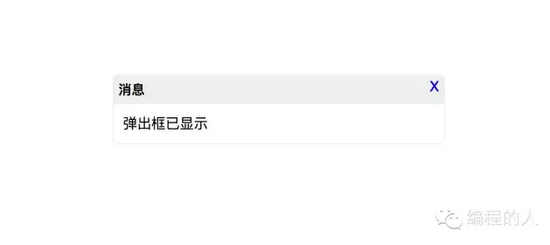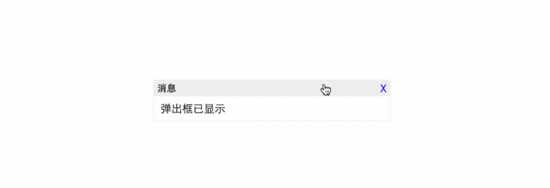Implement pop-up box effect based on JavaScript_javascript skills
Pop-up boxes are an indispensable part of website pages. Today, with the help of the Script House platform, I will share with you how to use js to achieve a simple pop-up box effect. This article is not well written, so please forgive me!

First, let’s analyze the components of the pop-up box. A simple pop-up box is divided into head, content, and tail. The head has a title and a close button, the content can be graphics, media, iframe, flash, etc., and the tail is the button ( Confirm, cancel, etc.), I will not add buttons at the end of this example. This example mainly implements the core part of the pop-up box.
<!DOCTYPE html>
<html>
<head>
<meta charset="UTF-8">
<title></title>
<style>
body, div{
padding: 0;
margin: 0;
}
html, body {
width: 100%;
height: 100%;
}
a {
text-decoration: none;
}
.pop {
border-radius: 5px;
background-color: #fff;
border: #eee 1px solid;
position: absolute;
width: 350px;
left: 35%;
top: 25%;
}
.pop-title {
background-image: linear-gradient(#eee,#efefef);
position: relative;
cursor: pointer;
}
.pop-title h3,.pop-title a{
display: inline-block;
}
.pop-title h3{
font-size: 14px;
margin: 0;
padding: 5px;
}
.pop-title a {
position: absolute;
top: 5px;
right: 5px;
}
.pop-content {
padding: 10px;
}
</style>
</head>
<body>
<div>
<div>
<h3>消息</h3>
<a href="javascript:;">X</a>
</div>
<div>
弹出框已显示
</div>
<div></div>
</div>
</body>
</html>A pop-up box will turn on the movement mode when the head is pressed, and prohibit movement when the head is released. In fact, this is what it means. Of course, the logic is relatively simple.
Here we may think of several variables, the X and Y coordinates of movement, the switch and prohibition of movement. Then we add onmousedown and onmouseup events to the title.
Onmousedown event mainly starts movement.
The logic in the onmouseup event is mainly to close the movement and disable the movement of the pop-up box.
Then we need to move, and when we need to move, we need to move within a certain range. Here we are moving inside the body. So add the onmousemove event to the body. What we do here is to move the position of the pop-up box.
These three events mainly combine the position attribute in CSS and the coordinates of the attributes in the Event event in JS.
var pop = document.getElementsByClassName("pop")[0];
var pop_title = pop.getElementsByClassName("pop-title")[0];
var bd = document.body;
var x = 0;
var y = 0;
var ismove = false; // 是否开启移动
var downx = 30;
var downy = 30;
pop_title.onmousedown = function (e) {
x = e.pageX;
y = e.pageY;
downx = e.offsetX;
downy = e.offsetY;
ismove = true;
}
bd.onmousemove = function (e) {
if (ismove) {
var cx = e.pageX - downx;
var cy = e.pageY - downy;
pop.style.left = cx + "px";
pop.style.top = cy + "px";
x = e.x;
y = e.y;
}
e.preventDefault();
}
pop_title.onmouseup = function (e) {
x = e.pageX;
y = e.pageY;
ismove = false;
console.log("移动完成")
}After moving the pop-up box, we add a close event to the close button.
//关闭
var pop_close = pop.getElementsByClassName("pop-close")[0];
pop_close.onclick = function () {
pop.parentNode.removeChild(pop);
}Okay, a simple pop-up box is implemented. The same code can be optimized and encapsulated by itself, and other functions can be added. Compatibility issues may need to be dealt with by yourself (versions before IE9).

That’s all for introducing the pop-up box effect using js. I hope it will be helpful to you!

Hot AI Tools

Undresser.AI Undress
AI-powered app for creating realistic nude photos

AI Clothes Remover
Online AI tool for removing clothes from photos.

Undress AI Tool
Undress images for free

Clothoff.io
AI clothes remover

Video Face Swap
Swap faces in any video effortlessly with our completely free AI face swap tool!

Hot Article

Hot Tools

Notepad++7.3.1
Easy-to-use and free code editor

SublimeText3 Chinese version
Chinese version, very easy to use

Zend Studio 13.0.1
Powerful PHP integrated development environment

Dreamweaver CS6
Visual web development tools

SublimeText3 Mac version
God-level code editing software (SublimeText3)

Hot Topics
 1665
1665
 14
14
 1424
1424
 52
52
 1322
1322
 25
25
 1270
1270
 29
29
 1250
1250
 24
24
 JavaScript Engines: Comparing Implementations
Apr 13, 2025 am 12:05 AM
JavaScript Engines: Comparing Implementations
Apr 13, 2025 am 12:05 AM
Different JavaScript engines have different effects when parsing and executing JavaScript code, because the implementation principles and optimization strategies of each engine differ. 1. Lexical analysis: convert source code into lexical unit. 2. Grammar analysis: Generate an abstract syntax tree. 3. Optimization and compilation: Generate machine code through the JIT compiler. 4. Execute: Run the machine code. V8 engine optimizes through instant compilation and hidden class, SpiderMonkey uses a type inference system, resulting in different performance performance on the same code.
 Python vs. JavaScript: The Learning Curve and Ease of Use
Apr 16, 2025 am 12:12 AM
Python vs. JavaScript: The Learning Curve and Ease of Use
Apr 16, 2025 am 12:12 AM
Python is more suitable for beginners, with a smooth learning curve and concise syntax; JavaScript is suitable for front-end development, with a steep learning curve and flexible syntax. 1. Python syntax is intuitive and suitable for data science and back-end development. 2. JavaScript is flexible and widely used in front-end and server-side programming.
 From C/C to JavaScript: How It All Works
Apr 14, 2025 am 12:05 AM
From C/C to JavaScript: How It All Works
Apr 14, 2025 am 12:05 AM
The shift from C/C to JavaScript requires adapting to dynamic typing, garbage collection and asynchronous programming. 1) C/C is a statically typed language that requires manual memory management, while JavaScript is dynamically typed and garbage collection is automatically processed. 2) C/C needs to be compiled into machine code, while JavaScript is an interpreted language. 3) JavaScript introduces concepts such as closures, prototype chains and Promise, which enhances flexibility and asynchronous programming capabilities.
 JavaScript and the Web: Core Functionality and Use Cases
Apr 18, 2025 am 12:19 AM
JavaScript and the Web: Core Functionality and Use Cases
Apr 18, 2025 am 12:19 AM
The main uses of JavaScript in web development include client interaction, form verification and asynchronous communication. 1) Dynamic content update and user interaction through DOM operations; 2) Client verification is carried out before the user submits data to improve the user experience; 3) Refreshless communication with the server is achieved through AJAX technology.
 JavaScript in Action: Real-World Examples and Projects
Apr 19, 2025 am 12:13 AM
JavaScript in Action: Real-World Examples and Projects
Apr 19, 2025 am 12:13 AM
JavaScript's application in the real world includes front-end and back-end development. 1) Display front-end applications by building a TODO list application, involving DOM operations and event processing. 2) Build RESTfulAPI through Node.js and Express to demonstrate back-end applications.
 Understanding the JavaScript Engine: Implementation Details
Apr 17, 2025 am 12:05 AM
Understanding the JavaScript Engine: Implementation Details
Apr 17, 2025 am 12:05 AM
Understanding how JavaScript engine works internally is important to developers because it helps write more efficient code and understand performance bottlenecks and optimization strategies. 1) The engine's workflow includes three stages: parsing, compiling and execution; 2) During the execution process, the engine will perform dynamic optimization, such as inline cache and hidden classes; 3) Best practices include avoiding global variables, optimizing loops, using const and lets, and avoiding excessive use of closures.
 Python vs. JavaScript: Community, Libraries, and Resources
Apr 15, 2025 am 12:16 AM
Python vs. JavaScript: Community, Libraries, and Resources
Apr 15, 2025 am 12:16 AM
Python and JavaScript have their own advantages and disadvantages in terms of community, libraries and resources. 1) The Python community is friendly and suitable for beginners, but the front-end development resources are not as rich as JavaScript. 2) Python is powerful in data science and machine learning libraries, while JavaScript is better in front-end development libraries and frameworks. 3) Both have rich learning resources, but Python is suitable for starting with official documents, while JavaScript is better with MDNWebDocs. The choice should be based on project needs and personal interests.
 Python vs. JavaScript: Development Environments and Tools
Apr 26, 2025 am 12:09 AM
Python vs. JavaScript: Development Environments and Tools
Apr 26, 2025 am 12:09 AM
Both Python and JavaScript's choices in development environments are important. 1) Python's development environment includes PyCharm, JupyterNotebook and Anaconda, which are suitable for data science and rapid prototyping. 2) The development environment of JavaScript includes Node.js, VSCode and Webpack, which are suitable for front-end and back-end development. Choosing the right tools according to project needs can improve development efficiency and project success rate.




